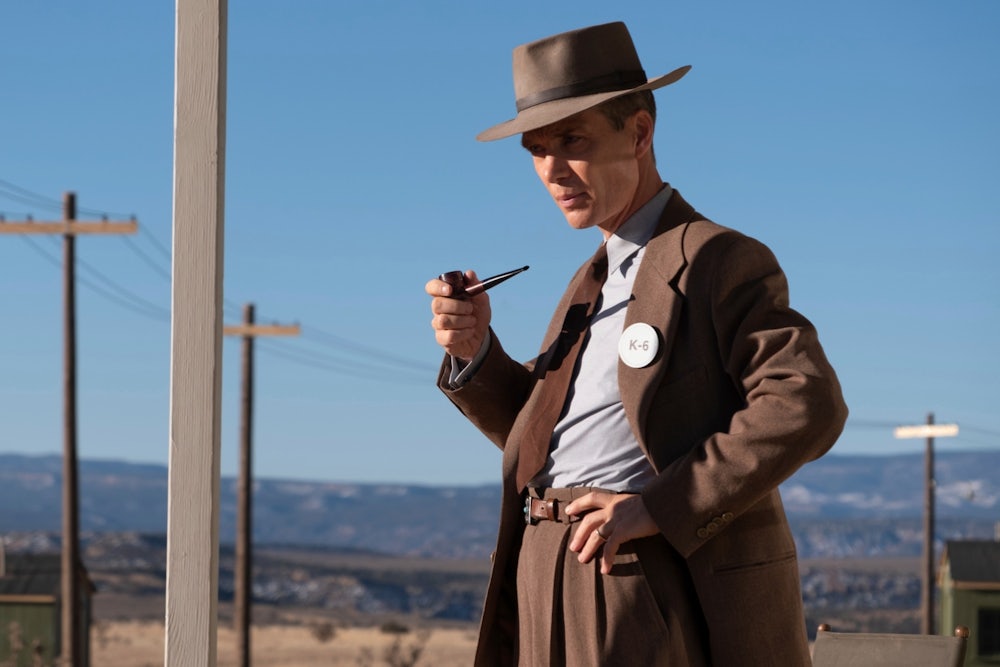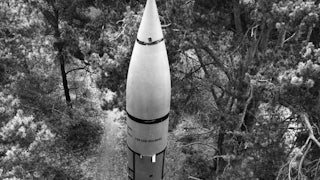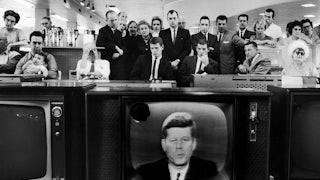Like many Americans, I was taught growing up that my grandfather was spared the burden of invading Japan and very likely dying because Harry Truman dropped a pair of atomic bombs on Hiroshima and Nagasaki and ended the war. The main function of such stories is to justify a terrible war crime, but they also serve to impress upon the listener that we are quite directly children of the atom—that the threat of nuclear warfare is a foundational fact of our age and that many of us owe our existence to it. The Japanese, of course, tell a very different story—for them, the memory of devastated, irradiated cities and as many as 200,000 murdered civilians is every bit as foundational.
The first atomic bombs were the output of a colossal secret research program funded by the U.S. government and run by theoretical physicist J. Robert Oppenheimer, who gathered the best minds in his field near a ranch he owned in the New Mexico desert, where the army-built town of Los Alamos sprang up practically overnight. Oppenheimer is now the titular subject of a big-budget Hollywood release by Christopher Nolan that, alongside Greta Gerwig’s Barbie, has been charged with rescuing the film industry from its post-pandemic doldrums.
Nolan, who is best known for puzzle boxes like Memento and Inception and for the Dark Knight trilogy, might seem an odd choice for a three-hour biopic that is mostly dialogue-driven and concerned as much with a McCarthy-era show trial as with the Manhattan Project, but Oppenheimer lives up to its considerable hype. That’s partly on the strength of the cast, which includes, among other luminaries, Cillian Murphy as the witty, obsessive, and sexually libertine Oppenheimer; Emily Blunt as his jaded and alcoholic wife, Kitty; Florence Pugh as his troubled Communist lover, Jean Tatlock; Matt Damon as General Leslie Groves, the army officer charged with overseeing the project; and Robert Downey Jr. as the cynical Atomic Energy Commission chairman and Oppenheimer-nemesis Lewis Strauss. But it’s also because Nolan clearly feels a deep investment in the moral stakes of his story and makes frequent use of bludgeoning audio cues and dreamlike glimpses of nuclear apocalypse to convey Oppenheimer’s torment as he ruminates on the bloody consequences of his theories.
A film depicting mostly quotidian human interaction is somehow paced like a thriller, and the tension never stops mounting, right up to the closing shot. When Groves, attempting to persuade one reluctant physicist to move to Los Alamos, calls the project “the most important fucking thing that’s ever happened,” you believe it.
Not having read the Pulitzer-winning biography American Prometheus, on which Oppenheimer is based, I was surprised by how much of Nolan’s film is focused on Oppenheimer’s left-wing associations, which brought him to the brink of disgrace in the years following his national renown at the end of World War II. Oppenheimer himself was more of a pro-labor fellow traveler, but his brother, his lover, at one point his wife, and many of his closest friends and colleagues were card-carrying members of the Communist Party and thus subject to accusations of loyalty to the Soviet Union under Joseph Stalin, which in some cases might even have been accurate. The rich and tragic history of American leftism is very rarely depicted in blockbuster movies, but Oppenheimer is a striking exception—not since Warren Beatty’s Reds (1981) has a mainstream Hollywood historical epic portrayed American Communists with such sympathy and nuance.
Even the basic structure of history may look very different from what audiences are used to. Many Americans are accustomed to thinking of World War II as the end of one era and the beginning of another, but for the American left, the war was a strange interregnum. Before Pearl Harbor, much of the American establishment and public was more frightened of communism than fascism, which is why a Jewish anti-fascist academic like Oppenheimer might find himself funneling money to the doomed Spanish Republicans via the Communist Party, since no one in Washington was going to help. After the defeat of Nazi Germany and Imperial Japan, the United States would almost immediately find itself in a Cold War competition with the Soviet Union, and soon any American with alleged left-wing associations could be blacklisted and driven from public life—even a figure as accomplished and admired as Oppenheimer. It was an aberration that for a period of less than four years in between Pearl Harbor and Hiroshima, the U.S. found itself allied with the Soviet Union in a global crusade against fascism—one in which Oppenheimer and his friends were not only aligned with their government but working with the highest levels of the U.S. military to produce a devastating weapon of war, which they hoped would be used against the Nazis.
The Manhattan Project, which represents both Oppenheimer’s career triumph and his most monstrous sin, occupies roughly the middle act of Nolan’s film. (I say “roughly” because, Nolan being Nolan, Oppenheimer’s chronology is fragmented and hard to summarize.) The successful Trinity detonation in New Mexico is as magnificent and terrifying on film as one might expect, but it’s no dramatic climax, and the subsequent bombings of Japan aren’t depicted on-screen at all. Instead, Oppenheimer is ultimately about how the U.S. government enlisted the talents of a group of mostly left-wing physicists it was never quite comfortable with in order to build a superweapon—one that it would never get the chance to use against the Nazis but that would be used against a nearly defeated Japan as a warning shot to the Soviets. The new, bipolar, frightfully dangerous world made possible by the atom bomb was a far cry from the harmonious global order its creators hoped and advocated for.
Nolan’s Los Alamos is something of a paradox. In the middle of the desert, the federal government lavishly funds a tiny utopia, where brilliant minds—many of them left-wing Jews, often refugees from Nazi-occupied Europe—gather with their families, isolated from the war and from their own society in an austere science camp, all for the sake of designing and testing a killing machine. (Though the film neglects to mention it, the isolation wasn’t total; some civilian communities downwind of the Trinity test site were exposed to radiation and negative health effects in the years that followed.) It’s a strange context, in which certain social norms are permitted to break down, as when a woman with a degree in the sciences is permitted to work on the project instead of being relegated to the typing pool—though this doesn’t stop her male colleagues from idly speculating on the risks radiation might pose to her reproductive organs. Everyone in Los Alamos has dignified work, housing, and enough to eat, and they form a tight-knit community into which a lot of babies are born. For a few years, the town is a perverse realization of a Communist dream serving the dictates of an empire that is anything but Communist.
By a strange coincidence, Oppenheimer is being released only weeks after Wes Anderson’s delightful Asteroid City, which portrays a fantasy military outpost in the Southwest clearly modeled on Los Alamos, down to the routine nuclear tests nearby. While Anderson’s town is fictional even within the context of the film, it reflects the same promise and peril as the real Los Alamos, functioning both as a commune for earnest young scientific minds and a military dictatorship hiding a terrible secret. In their own trademark styles, Anderson and Nolan both speak to the fascination that the Manhattan Project held for a generation of midcentury intellectuals made to reckon with the destructive potential of science and the unwieldy relationship between America’s best minds and its military-industrial complex.
Nolan’s Oppenheimer wills Los Alamos into existence because of his personal connection to the land, and when the war is over he advocates for it to be returned to the local Indigenous population, which the military has no intention of doing; today, thousands of Americans live there, and the town is still dedicated to atomic research. In the confrontation between Oppenheimer’s high-minded justifications for his work and the military’s more cynical ends, Nolan leaves no doubt as to which prevailed.
In the final moments of the film, Oppenheimer is seen confiding to an aged Albert Einstein (Tom Conti), whose own theories a generation earlier paved the way for the Manhattan Project, that he believes he may have started a chain reaction that will destroy the world. For those of us who grew up at the End of History, with the Soviet Union dissolved and both superpowers’ nuclear arsenals downsized and brought under tighter control, it might be tempting to conclude that Oppenheimer was too pessimistic and that the weapon he built could be managed responsibly and never used in warfare again.
But Oppenheimer turns out to be uncomfortably timely. At no point since the end of the Cold War has nuclear war felt more plausible, as the daily clashes between a nuclear-armed Russia and a NATO-backed Ukraine remind us. Beyond literal nuclear warfare, we are faced with a range of existential dangers—pandemics, climate change, and perhaps artificial intelligence—that will be managed, or mismanaged, by small teams of scientific experts working in secret with little democratic accountability. The ideologies, affiliations, and personalities of those experts are likely to leave their stamp on history, and not in ways they themselves would necessarily wish. Oppenheimer’s dark prophecy may yet be fulfilled.






